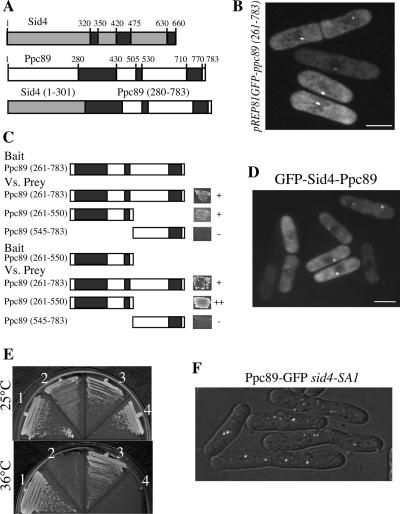Figure 4.
The essential function of the Sid4 C-terminus in SIN signaling is SPB targeting. (A) Schematic representation of Sid4, Ppc89, and a Sid4-Ppc89 fusion. Predicted coiled-coil domains are indicated by black boxes. Numbers indicate amino acids. (B) Wild-type cells (KGY246) expressing GFP-ppc89 (261–783) from the pREP81 vector were grown in the absence of thiamine for 18 h at 32°C. An image of live cells was captured. (C) Bait and prey vectors expressing the indicated regions of Ppc89 were cotransformed into S. cerevisiae strain PJ69-4A. Transformants carrying both plasmids were scored for growth on a medium selecting for a two-hybrid interaction, as indicated to the right of the schematics. Black boxes indicate regions of predicted coiled coil. (D) sid4-SA1 cells (KGY1234) were transformed with pREP81-GFPsid4-ppc89, and live-cell images were captured after 24 h of growth in the absence of thiamine at 25°C. (E) Strain KGY1234 was transformed with pREP81sid4+ (1), pREP81ppc89+ (2), pREP81sid4-ppc89 (3), and pREP81 (4). Transformants were incubated on medium lacking thiamine at 25°C (top panel) or 36°C (bottom panel) for 4 d. (F) ppc89-GFP sid4-SA1 cells (KGY4325) were incubated at the restrictive temperature of 36°C for 4 h, and live-cell images were captured. Bars, 5 μm.

